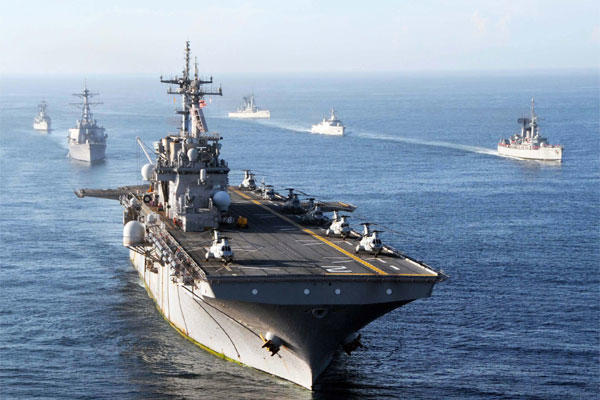Chief of Naval Operations Adm. Jonathan Greenert told lawmakers Wednesday that the Navy would need a 450-ship fleet in order to meet the global needs of combatant commanders.
"For us to meet what combatant commanders request, we need a Navy of 450 ships," he told the House Armed Services Committee.
Officially, the Navy's position is to achieve a 306-ship fleet by the end of the decade, service officials said. At the moment there are 289 ships in the Navy, according to service officials who said the number reflects a new method of counting ships.
The new counting method, based on what the Navy calls a global force allocation management plan, adds hospital ships and forward-positioned patrol craft to the ship-counting methodology. In addition, the new counting procedure only counts forward-deployed mine countermeasure ships and does not count those that are not deployed.
As a result of the new ship-counting method, the Navy's current ship total jumps from 284 to 289.
Overall, the Navy requested $148 billion for fiscal year 2015, a $38 billion decrease over a projected five-year period when compared with last year's budget request.
Rep. Howard "Buck" McKeon, chairman of the House Armed Services Committee, expressed concern at the posture hearing that the fiscal year 2015 budget request will amount to a dismantling of the Navy.
"These drastic nonsensical cuts should stir immense debate. Is this the Navy America wants? The security environment and need for Naval forces have not abated, yet this is a fundamental, piecemeal dismantling of the world's greatest Navy," McKeon said.
Rep. Randy Forbes, R-Va., Chairman of the HASC Seapower and Projection Forces Subcommittee, expressed concern that a decreasing percentage of requests from commanders were being met.
"In 2007 we met 90-percent of the combatant commander's requirements. This year we will only meet 43 percent," Forbes said.
McKeon said the budget does not include money to refuel the USS George Washington, an aircraft carrier slated to go through a four year refueling beginning in 2016.
However, there has been discussion and debate about potentially retiring the USS George Washington instead of spending the money to refuel the ship and extending its life for another 25 years of service. Retiring the USS George Washington would drop the Navy's carrier fleet down from 11 to 10 carriers.
"Last week Admiral Locklear, the commander of U.S. Pacific Fleet, indicated that the Navy cannot meet the global demand for aircraft carriers, yet the budget request contains no funding for refueling and overhaul, forcing the Navy to decommission the USS George Washington which has over 25 years of hull life," McKeon said.
Mabus indicated that the fate of the USS George Washington remains up in the air.
"We want to keep the 11th carrier and its associated air wing very much. What we've done with this budget is move that decision to FY 16 so that there is time to debate it and take a close look at what would be the realities if we did decommission it," Mabus said.
Mabus also spelled out a handful of the impacts which would be associated with dropping the Navy's carrier fleet down to 10. Deployments of the remaining carriers would be longer, the Navy's global forward presence would be diminished, carrier maintenance would be much more challenging and the U.S. industrial base would be adversely affected, he described.
Although Mabus said there would be serious consequences associated with retiring the carrier, he stressed that the $7 billion needed to refuel the USS George Washington would be tough to come by.
"There are very few places that you can find seven billion dollars in any budget," he told the committee.
Addressing the need for carriers, Chief of Naval Operations Adm. Jonathan Greenert told the committee that Pacific Fleet Commander Adm. Samuel Locklear needs two full-time carriers stationed in the Pacific theater. In fact, he said that a third carrier would be needed for three to four months out of the year.
Greenert also said dropping to 10 carriers would decrease the ability of the Navy to fill what he called deterrence gaps and also increase risk.
Forbes said that $243 million put in the 2015 budget by the House Armed Services Committee to prepare for refueling the USS George Washington has been taken out of the budget.
"There's a huge disconnect between the rhetoric we're hearing and the actions that are being taken," Forbes said.



























